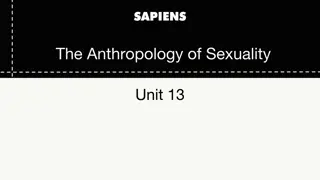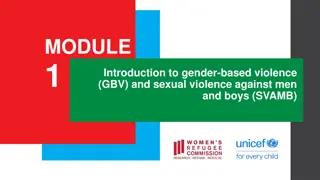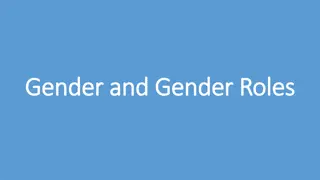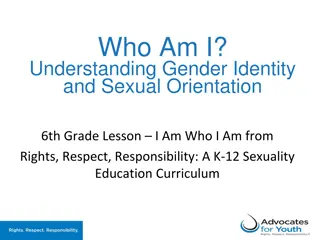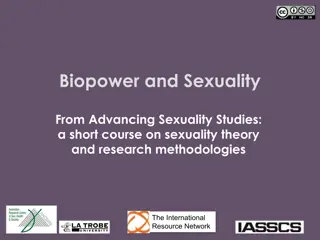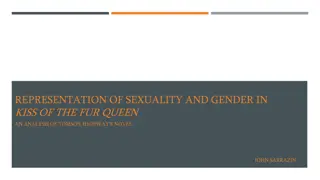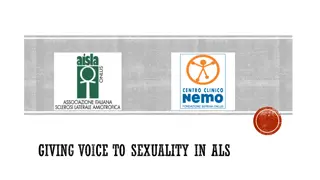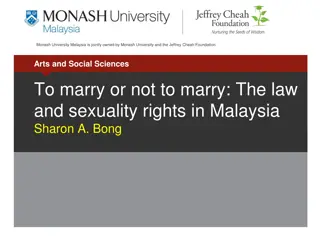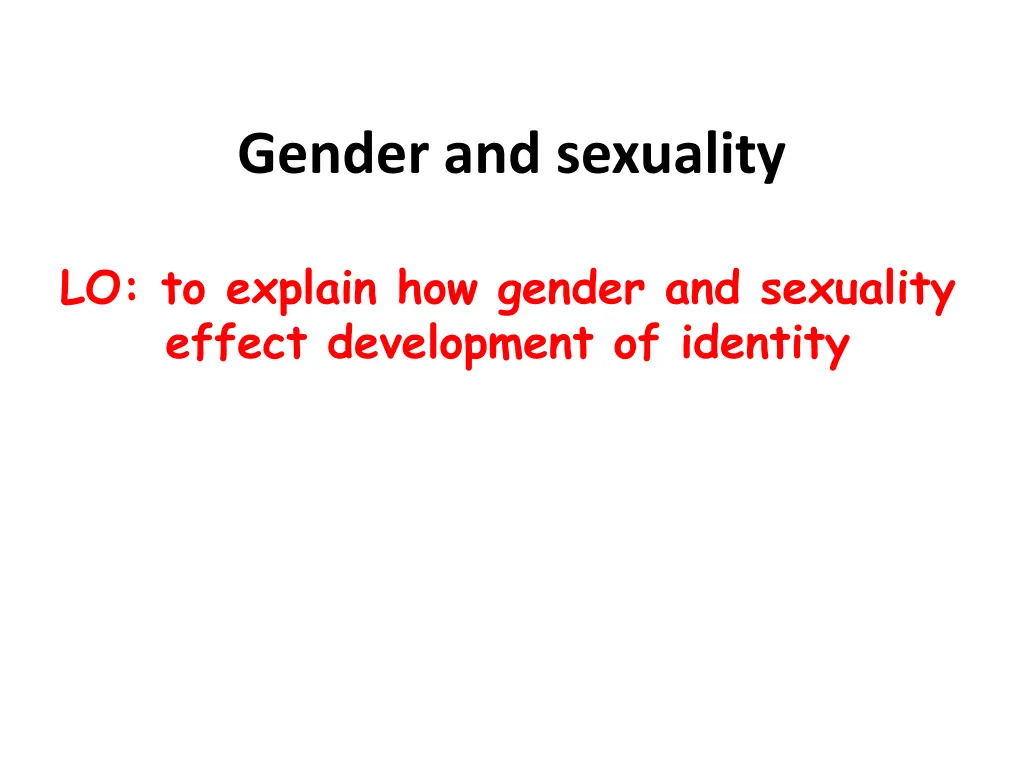
Understanding Gender and Sexuality's Impact on Identity Development
Explore how gender and sexuality influence the development of identity, from understanding the differences between sex and gender to evaluating the positive and negative consequences on individual identity. Delve into sociological theories supporting the impact of gender and sexuality on identity formation.
Download Presentation

Please find below an Image/Link to download the presentation.
The content on the website is provided AS IS for your information and personal use only. It may not be sold, licensed, or shared on other websites without obtaining consent from the author. If you encounter any issues during the download, it is possible that the publisher has removed the file from their server.
You are allowed to download the files provided on this website for personal or commercial use, subject to the condition that they are used lawfully. All files are the property of their respective owners.
The content on the website is provided AS IS for your information and personal use only. It may not be sold, licensed, or shared on other websites without obtaining consent from the author.
E N D
Presentation Transcript
Gender and sexuality LO: to explain how gender and sexuality effect development of identity
Learning outcomes All will be able to explain how gender and sexuality effects the development of identity (G-D) Most will be able to evaluate the positive and negative consequences of gender and sexuality on identity (C-B) Some will be able to use sociological theories to support evaluation of impact on development of identity (B-A)
LO: to explain how gender and sexuality effect development of identity All will be able to explain how gender and sexuality effects the development of identity (G-D) Most will be able to evaluate the positive and negative consequences of gender and sexuality on identity (C-B) Some will be able to use sociological theories to support evaluation of impact on development of identity (B-A) Sort these words into 3 groups : those you could use to describe women, those you could use to describe men and those that could be used for both passive assertive emotional pretty sweet ruthless bitchy slim hunk blonde babe dog sulky gentle gossip tart logical delicate weak submissive handsome beautiful fit trophy bird clever powerful bimbo aggressive cold sly muscular domineering hideous hysterical cute loose thoughtful caring elegant kind quiet brave clinging frigid raving player mover easy bastard attractive soft tender competitive active slag gracious plain stud dickhead slut
LO: to explain how gender and sexuality effect development of identity All will be able to explain how gender and sexuality effects the development of identity (G-D) Most will be able to evaluate the positive and negative consequences of gender and sexuality on identity (C-B) Some will be able to use sociological theories to support evaluation of impact on development of identity (B-A) Gender and identity
LO: to explain how gender and sexuality effect development of identity All will be able to explain how gender and sexuality effects the development of identity (G-D) Most will be able to evaluate the positive and negative consequences of gender and sexuality on identity (C-B) Some will be able to use sociological theories to support evaluation of impact on development of identity (B-A) What the difference between sex and gender ? Sex describes the biological differences between males and females, e.g. chromosomes, hormones and genitals Gender refers to cultural expectations which go with how males and females are supposed to behave these are known as gender roles.
LO: to explain how gender and sexuality effect development of identity All will be able to explain how gender and sexuality effects the development of identity (G-D) Most will be able to evaluate the positive and negative consequences of gender and sexuality on identity (C-B) Some will be able to use sociological theories to support evaluation of impact on development of identity (B-A) KEY POINT Sociologists say that gender is socially constructed rather than biologically determined. In other words nurture is more important than nature, e.g. feminist sociologists see gender as shaped by a social and cultural environment dominated by a culture of patriarchy (male culture) Gender expectations regarding masculine and feminine identities are passed on to the next generation through gender-role socialisation
LO: to explain how gender and sexuality effect development of identity All will be able to explain how gender and sexuality effects the development of identity (G-D) Most will be able to evaluate the positive and negative consequences of gender and sexuality on identity (C-B) Some will be able to use sociological theories to support evaluation of impact on development of identity (B-A) Hegemonic definitions of men and women These are a set of ideas about how men and women should behave. These ideas have dominated British culture until very recently. Connell (2002) explained some of these ideas: Men and women have very different roles in the family women are maternal and take responsibility for the housework, men are expected to be head of the house and the breadwinner (bring in the main wages into the house). Women are expected to show emotion and affection Men are expected to show little emotion Aggression, being rational and being tough are seen as positive for men Women are judged on their looks where are men are judged on a wider range of things such as intelligence and skills Men can be sexual promiscuous, women can t as it is seen deviant female behaviour
LO: to explain how gender and sexuality effect development of identity All will be able to explain how gender and sexuality effects the development of identity (G-D) Most will be able to evaluate the positive and negative consequences of gender and sexuality on identity (C-B) Some will be able to use sociological theories to support evaluation of impact on development of identity (B-A) Hegemonic masculine characteristics Hegemonic feminine characteristics Heterosexuality Heterosexuality Sexual dominance Sexual passive (or slapper if sexually active Repression of emotions/emotional distance (except in sports, when males tend to get very emotional) Expression of emotions/emotional warmth, caring and sensitive Physical strength/ muscular/tall Weak, fragile/small Aggression Gentleness and non-aggressive Independence and self-reliance Dependence (on men) Competitiveness and ambition Non-competitive Lack of domesticity (housework and childcare) only occasional practical DIY round home Concerned with and responsible for homework and practical and emotional aspects of childcare Rational and practical Emotional and unpredictable Risk taking Avoids risks Task-oriented focus on doing things like work success, playing sports, making things, DIY in the home or activities to escape from work People-orientated focus on forming and maintaining friendships, family, children and customer care Lack of concern with or interest in personal appearance, taste in dress or poor personal health and diet Major concern with physical appearance , health, diet, dress sense, and attractiveness to men
LO: to explain how gender and sexuality effect development of identity All will be able to explain how gender and sexuality effects the development of identity (G-D) Most will be able to evaluate the positive and negative consequences of gender and sexuality on identity (C-B) Some will be able to use sociological theories to support evaluation of impact on development of identity (B-A) The family and gender-role socialisation From an early age children are socialised to conform with expectations associated with their gender. Oakley (1982) identifies four processes at the centre of making a gender identity: Manipulation how parents encourage or discourage behaviour on the basis of appropriateness for the sex Canalization how parents channel children s interests into toys and activities seen as normal for that sex Domestic activities girls will help their mothers with housework which reinforces expectations of how they should behave in later life Verbal appellations use stereotypical terms like pretty for girls and handsome for boys to reinforce cultural expectations of the different genders
LO: to explain how gender and sexuality effect development of identity All will be able to explain how gender and sexuality effects the development of identity (G-D) Most will be able to evaluate the positive and negative consequences of gender and sexuality on identity (C-B) Some will be able to use sociological theories to support evaluation of impact on development of identity (B-A) Manipulation Canalization The family and gender-role socialisation Domestic activities Verbal appellations
LO: to explain how gender and sexuality effect development of identity All will be able to explain how gender and sexuality effects the development of identity (G-D) Most will be able to evaluate the positive and negative consequences of gender and sexuality on identity (C-B) Some will be able to use sociological theories to support evaluation of impact on development of identity (B-A) Gender codes Statham (1986) found that by the age of 5, most children have got a clear gender identity. They know what gender they belong to and have a clear idea about what is appropriate behaviour for their gender Gender-role socialisation involves learning gender codes which result in social conformity to expectations about appropriate gender behaviour. These include: Colour codes parents dress boys in blue and girls in pink Appearance codes we learn what dress, hairstyles, cosmetics and jewellery are appropriate for males and females
LO: to explain how gender and sexuality effect development of identity All will be able to explain how gender and sexuality effects the development of identity (G-D) Most will be able to evaluate the positive and negative consequences of gender and sexuality on identity (C-B) Some will be able to use sociological theories to support evaluation of impact on development of identity (B-A) Toy codes gender specific toys support the ideas about what are the expected future gender roles -girls play with dolls in preparation for being mothers, boys get aggressive (action) toys and creative toys (Lego) Play codes - boys are expected to play boisterously where are girls are expected to play in a nicer way Control codes boys and girls are subjected to different types of social control especially when they become teenagers- girls are more likely to be interrogated more than boys about their social lives, boyfriends, etc; than boys
LO: to explain how gender and sexuality effect development of identity All will be able to explain how gender and sexuality effects the development of identity (G-D) Most will be able to evaluate the positive and negative consequences of gender and sexuality on identity (C-B) Some will be able to use sociological theories to support evaluation of impact on development of identity (B-A) Check your understanding 1. Identify the differences between sex and gender . 2. Explain, using examples, what is meant by the hegemonic masculinity and femininity. 3. Explain why the family is the most important agency of gender-role socialisation.
LO: to explain how gender and sexuality effect development of identity All will be able to explain how gender and sexuality effects the development of identity (G-D) Most will be able to evaluate the positive and negative consequences of gender and sexuality on identity (C-B) Some will be able to use sociological theories to support evaluation of impact on development of identity (B-A) Education and gender socialisation Studies in education in the 1970s suggested that teacher and schools saw female education, especially in the sciences, as less important than male education. Sue Sharpe s (1994) survey of working class girls in the early 1970s found that such experiences meant that female identity revolved around love, marriage, husbands, children, jobs and careers more or less in that order
LO: to explain how gender and sexuality effect development of identity All will be able to explain how gender and sexuality effects the development of identity (G-D) Most will be able to evaluate the positive and negative consequences of gender and sexuality on identity (C-B) Some will be able to use sociological theories to support evaluation of impact on development of identity (B-A) Mass media and gender-role socialisation Billington et al (1998) argued that the mass media traditionally show masculinity as dominant and femininity as submissive. Women are shown in a narrow range of roles whereas men are shown doing a full range of social roles Women are rarely shown in high-status occupations instead they are shown in a domestic setting (housewives, contented mothers etc) Women are often presented as objects to be enjoyed by men The most extreme media version of this is pornography and Page 3 girls in newspapers.
LO: to explain how gender and sexuality effect development of identity All will be able to explain how gender and sexuality effects the development of identity (G-D) Most will be able to evaluate the positive and negative consequences of gender and sexuality on identity (C-B) Some will be able to use sociological theories to support evaluation of impact on development of identity (B-A) After reading pgs. 67-68 of the Browne book answer the following questions 1. How is gender socialization learned through schools? 2. What 2 areas form the main part of gender socialization in schools and explain how they work? 3. Why are peer groups important to gender socialization? 4. In what ways does mass media effect gender socialization? 5. How does mass media present stereotypical views of women?
LO: to explain how gender and sexuality effect development of identity All will be able to explain how gender and sexuality effects the development of identity (G-D) Most will be able to evaluate the positive and negative consequences of gender and sexuality on identity (C-B) Some will be able to use sociological theories to support evaluation of impact on development of identity (B-A) Gender identity and social change Four major changes occurred in the late twentieth century which have challenged traditional ideas of masculinity and femininity and led to new forms of gender identity When the British economy went into decline due to the global recession there was large scale male unemployment. This undermined the traditional male identity of worker and breadwinner. Mac An Ghaill argues that this has led to a crisis in masculinity this has been made worse by social problems like domestic violence, boys underachievement in school and suicide among young men 1
LO: to explain how gender and sexuality effect development of identity All will be able to explain how gender and sexuality effects the development of identity (G-D) Most will be able to evaluate the positive and negative consequences of gender and sexuality on identity (C-B) Some will be able to use sociological theories to support evaluation of impact on development of identity (B-A) As heavy industry and manual work has declined, the public sector (jobs in health, education), the retail sector and financial services where many more women are employed has become more important. Many of these working women decided to postpone having children in favour of having a career. 2 Due to more women being in the workplace and more positive female role models has led to what Wilkinson calls a gender quake (a radical change in feminine identity).Sharpe repeated her survey in the 1990s and found that girls prioritise had drastically changed, careers and independence were now the most important to them. The genderquake can be seen most clearly in education girls are significantly outperforming boys. 3
LO: to explain how gender and sexuality effect development of identity All will be able to explain how gender and sexuality effects the development of identity (G-D) Most will be able to evaluate the positive and negative consequences of gender and sexuality on identity (C-B) Some will be able to use sociological theories to support evaluation of impact on development of identity (B-A) Changes in female identities Post-modernist argue that society today is characterised by greater choice because of globalisation and greater levels of consumption. The increased economic independence of women mean women are now seen as important consumers by the mass media and that leisure activities and consumption are the most significant ways in which views on masculine and feminine identity are made. This has supposedly led to the emergence of girl power and ladettes who increasingly adopt male forms of behaviour (drinking and smoking heavily and being sexually aggressive) 4
LO: to explain how gender and sexuality effect development of identity All will be able to explain how gender and sexuality effects the development of identity (G-D) Most will be able to evaluate the positive and negative consequences of gender and sexuality on identity (C-B) Some will be able to use sociological theories to support evaluation of impact on development of identity (B-A) Changes in male identities Since the 1980s there has been speculation about the emergence of a so-called New Man , who was allegedly more caring, more likely to share, express emotional needs and a willingness to do their fair share of the housework. Love, family, personal relations and getting in touch with his own emotions were meant to be more important than achieving career success and power in the family and in society. These new male identities are becoming more concerned with appearance (8% of plastic surgery is now carried out on men) recent research shows men of all ages are now worrying about their appearance.
LO: to explain how gender and sexuality effect development of identity All will be able to explain how gender and sexuality effects the development of identity (G-D) Most will be able to evaluate the positive and negative consequences of gender and sexuality on identity (C-B) Some will be able to use sociological theories to support evaluation of impact on development of identity (B-A) Changes in male identities Male bodies are now emerging in advertising as sex objects to sell things, in much the same way as women s bodies have always been used. The growth of eating disorders, like anorexia, among men, and Men s Health weeks suggest a new concern with men s health and attractiveness
LO: to explain how gender and sexuality effect development of identity All will be able to explain how gender and sexuality effects the development of identity (G-D) Most will be able to evaluate the positive and negative consequences of gender and sexuality on identity (C-B) Some will be able to use sociological theories to support evaluation of impact on development of identity (B-A) New Bloke a New Lad who has become a recent father, but who as well as hanging out in the pub is also to be found changing nappies Metrosexuals heterosexual men who embrace their feminine side, are in touch with their feelings, use moisturiser and designer cosmetic products, who have refined tastes in clothing, and incorporate elements of the gay lifestyle New Lad a reaction against the New Man, associated with yob culture of aggressive and promiscuous sex, lager, football and loutishness other male identities that have been shown in the mass media New Dad a New Man who discovers the joys of fatherhood Emo Boy a version of New Man, who reads books, appreciates the arts, watches his diet, isn t afraid of showing his emotions and dresses with more care and style than most girls, usually in tight sweaters and trousers
LO: to explain how gender and sexuality effect development of identity All will be able to explain how gender and sexuality effects the development of identity (G-D) Most will be able to evaluate the positive and negative consequences of gender and sexuality on identity (C-B) Some will be able to use sociological theories to support evaluation of impact on development of identity (B-A) Check your understanding 1. How do mass media representations of masculinity and femininity reinforce traditional stereotypes about men and women? 2. How have economic and social changes contributed to the emergence of new types of masculinity and femininity?
LO: to explain how gender and sexuality effect development of identity All will be able to explain how gender and sexuality effects the development of identity (G-D) Most will be able to evaluate the positive and negative consequences of gender and sexuality on identity (C-B) Some will be able to use sociological theories to support evaluation of impact on development of identity (B-A) Sexuality and identity In Britain, heterosexual identity has been traditionally seen as the dominant or ideal form of sexuality because of its links to reproduction. In contrast, homosexuality was seen in the early part of the twentieth century as a form of criminal and abnormal sexuality, and it was consequently punishable by law.
However, by the 1990s, a distinct gay sub-culture and identity had emerged in British culture for several reasons: LO: to explain how gender and sexuality effect development of identity All will be able to explain how gender and sexuality effects the development of identity (G-D) Most will be able to evaluate the positive and negative consequences of gender and sexuality on identity (C-B) Some will be able to use sociological theories to support evaluation of impact on development of identity (B-A) Homosexual acts between consenting adults was gradually de-criminalised to the extent that homosexuals are now permitted to enter a type of marriage the civil partnership. Cultural attitudes towards homosexuality began to shift. The decision of people in the public eye to come out probably made this more socially acceptable Gay culture became politicised in the 1970s onwards as organisations like Stonewall, campaigned for changes in the law so that homosexuals enjoyed the same rights as heterosexuals Gay professionals have a great deal of spending power and the leisure industry began to target the pink pound from the 1980s onwards In cities such as London, Manchester and Brighton, Gay Pride marches tried to increase the visibility and social acceptance of gay people
LO: to explain how gender and sexuality effect development of identity All will be able to explain how gender and sexuality effects the development of identity (G-D) Most will be able to evaluate the positive and negative consequences of gender and sexuality on identity (C-B) Some will be able to use sociological theories to support evaluation of impact on development of identity (B-A) Match the picture with a reason why gay sub- culture have emerged since the 1990s
LO: to explain how gender and sexuality effect development of identity All will be able to explain how gender and sexuality effects the development of identity (G-D) Most will be able to evaluate the positive and negative consequences of gender and sexuality on identity (C-B) Some will be able to use sociological theories to support evaluation of impact on development of identity (B-A) Gay subculture Rich (1984) suggests that the emergence of gay and lesbian subcultures is remarkable considering Western societies tend to have compulsory heterosexuality.
LO: to explain how gender and sexuality effect development of identity All will be able to explain how gender and sexuality effects the development of identity (G-D) Most will be able to evaluate the positive and negative consequences of gender and sexuality on identity (C-B) Some will be able to use sociological theories to support evaluation of impact on development of identity (B-A) compulsory heterosexuality Is mainly passed on through mass media , e.g homosexuality is rarely shown as a normal or ideal condition There is still evidence of homophobia in the worlds of business, sport and politics. Religious organisations too continue to criticise homosexuality as sinful, wicked and immoral. Homophobic attacks on gay people are still relatively common and suggest that this type of sexuality is still not totally accepted by all sections of the community.
LO: to explain how gender and sexuality effect development of identity All will be able to explain how gender and sexuality effects the development of identity (G-D) Most will be able to evaluate the positive and negative consequences of gender and sexuality on identity (C-B) Some will be able to use sociological theories to support evaluation of impact on development of identity (B-A) Heterosexuality and identity Heterosexuality can be seen as a product of culture rather than biology. This can be shown by looking at what has and is considered to be sexual attractive. From looking at painting from the 18th and 19th century plump women were seen as the ideal. Even into the 1950s female sex icons like Marilyn Monroe were much bigger than the supermodels and celebrities seen in modern society as being the most sexually attractive
LO: to explain how gender and sexuality effect development of identity All will be able to explain how gender and sexuality effects the development of identity (G-D) Most will be able to evaluate the positive and negative consequences of gender and sexuality on identity (C-B) Some will be able to use sociological theories to support evaluation of impact on development of identity (B-A) 18TH and 19TH century images of beautiful women Early 20th century images of beautiful women Late 20th century images of beautiful women
LO: to explain how gender and sexuality effect development of identity All will be able to explain how gender and sexuality effects the development of identity (G-D) Most will be able to evaluate the positive and negative consequences of gender and sexuality on identity (C-B) Some will be able to use sociological theories to support evaluation of impact on development of identity (B-A) Feminist perspectives Some have suggested that these types of media image of femininity may be responsible for eating disorders in modern societies. Hunt (2001) argues that the media recognises society s obsession with looking slim and carries on this idea by suggesting that slimness equals success, health, happiness and popularity. Although images of an ideal male body are increasingly being shown in the media, there is little sign that it his having the equivalent effect on men.
LO: to explain how gender and sexuality effect development of identity All will be able to explain how gender and sexuality effects the development of identity (G-D) Most will be able to evaluate the positive and negative consequences of gender and sexuality on identity (C-B) Some will be able to use sociological theories to support evaluation of impact on development of identity (B-A) Another clue that heterosexuality is formed by culture rather than biology is the double standard that exists been attitudes towards male and female sexual behaviour. Men and women are seen to have different sexual identities. Men are seen as promiscuous predators (they want to have sex with as many women as possible) Women are seen as passive and more interested in love than sex.
LO: to explain how gender and sexuality effect development of identity All will be able to explain how gender and sexuality effects the development of identity (G-D) Most will be able to evaluate the positive and negative consequences of gender and sexuality on identity (C-B) Some will be able to use sociological theories to support evaluation of impact on development of identity (B-A) Double standards? Due to the idea that women are more interested in love than sex, women can face social risks if they do not conform to this idea Lees (1986) found that women are subjected to being labelled as a slag or a slapper by both men and women if they appear to behave in similar ways to men
LO: to explain how gender and sexuality effect development of identity All will be able to explain how gender and sexuality effects the development of identity (G-D) Most will be able to evaluate the positive and negative consequences of gender and sexuality on identity (C-B) Some will be able to use sociological theories to support evaluation of impact on development of identity (B-A) Check your understanding 1. How have sexual identities evolved over the last 50 years?
LO: to explain how gender and sexuality effect development of identity All will be able to explain how gender and sexuality effects the development of identity (G-D) Most will be able to evaluate the positive and negative consequences of gender and sexuality on identity (C-B) Some will be able to use sociological theories to support evaluation of impact on development of identity (B-A)


